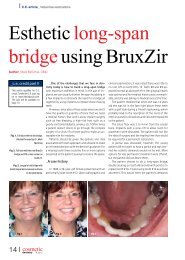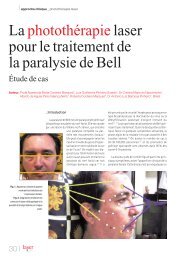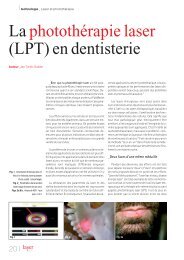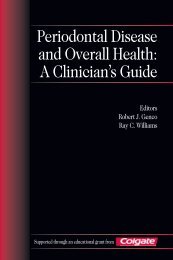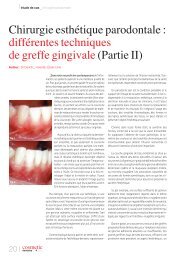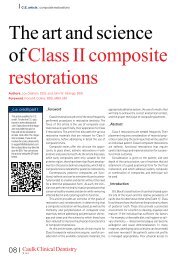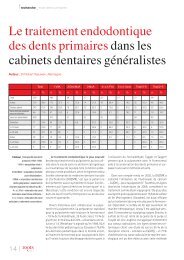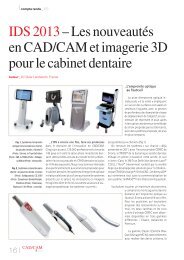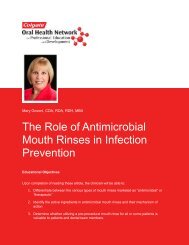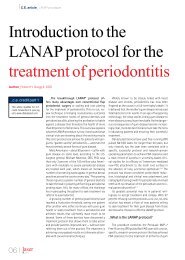Periodontal Disease and Overall Health: A Clinician's Guide
Periodontal Disease and Overall Health: A Clinician's Guide
Periodontal Disease and Overall Health: A Clinician's Guide
You also want an ePaper? Increase the reach of your titles
YUMPU automatically turns print PDFs into web optimized ePapers that Google loves.
CHAPTER 3 Infection <strong>and</strong> Inflammation 29during which time the induced responses ofinnate immunity continue to function. Eventually,antigen-specific T cells <strong>and</strong> then antibodiesare released into the blood to targetthe infection site. 15 Macrophages that engulfbacteria at the site of infection express costimulatorymolecules (MHC-II) <strong>and</strong> presentbacterial antigens on their surface. AntigenspecificT cells “see” the antigens <strong>and</strong> activatethe macrophages, enabling them to destroyintracellular bacteria more efficiently.In addition, secreted antibodies protect thehost from infection by: (a) inhibiting thetoxic effects or infectivity of pathogens bybinding (neutralization); (b) opsonizing thepathogens <strong>and</strong> promoting phagocytosis; <strong>and</strong>(c) activating the complement system.Failureto clear the infection at this point leads to furthertissue damage. Activated macrophagesproduce oxygen radicals, NO, <strong>and</strong> proteasesin the gingival tissues that are toxic to thehost cells. Moreover, recent work on a mousemodel revealed that the induction of anadaptive immune response to colonizingpathogens results in receptor activator of nuclearfactor-kappaB lig<strong>and</strong>-dependent perio -dontal bone loss. 16Summary of Part IThe trigger that causes the shift fromtissue homeostasis to pathology remains unclear.The logical extension of Löe’s observationis that this is caused by specific bacteria<strong>and</strong> indeed, a large body of evidencesuggests that certain bacteria are associatedwith progressive disease. However, studies ofthe microbiota of the periodontal lesion arecross-sectional <strong>and</strong> definitive cause/effectrelationships have not been demonstrated.Recently, a longitudinal study of periodontaldisease progression failed to implicate anysingle organism or group of organisms inthe initiation of periodontal attachmentloss. 17 In addition, recent animal studies suggestthat the level of host inflammation hasa major impact on the composition of thebiofilm. Interestingly, inflammation is astronger predictor of periodontal attachmentloss than the composition or quantity of theoral biofilm. 17 Clearly, the etiology <strong>and</strong>pathogenesis of periodontitis requires furtherstudy. It is also apparent that “traditional”periodontal pathogens (Socransky’s“red complex”) contribute to <strong>and</strong> acceleratedisease when they overgrow in the perio -dontal environment. However, the role of inflammation<strong>and</strong> the host immune responsehas taken on a new perspective, potentiallydetermining susceptibility <strong>and</strong> providing anovel therapeutic target.PART II: SYSTEMIC INFLAMMATIONDUE TO PERIODONTAL INFECTIONDespite the localized nature of perio -dontal disease, infection of the sulcus/perio -dontal pocket with periodontopathogens maybe responsible for inflammatory responsesthat develop beyond the periodontium. Todate, several biological pathways have beenrecognized that present reasonable hypothesesfor periodontal disease induction of systemicinflammation.Inflammatory PathwaysIn health, the sulcular epithelium alongwith innate immune molecules acts as a naturalbarrier system that inhibits <strong>and</strong> eliminatespenetrating bacteria. Hence, only asmall number of bacteria, mostly facultative,manage to enter the gingival tissues <strong>and</strong> thebloodstream. However, in cases of perio -dontal disease, the inflamed <strong>and</strong> ulceratedpocket epithelium is vulnerable to bacterialpenetration <strong>and</strong> forms an easy port of entryfor the bacteria. This leads to an increase inthe number of periodontopathogens, mainlyanaerobic Gram-negative, in the gingival tissues<strong>and</strong> consequently in the circulation.Bacteremia can be initiated after mechanicalirritation of the inflamed gingiva during toothbrushing, chewing, oral examination, <strong>and</strong>scaling <strong>and</strong> root planing. 18 The microorgan-



